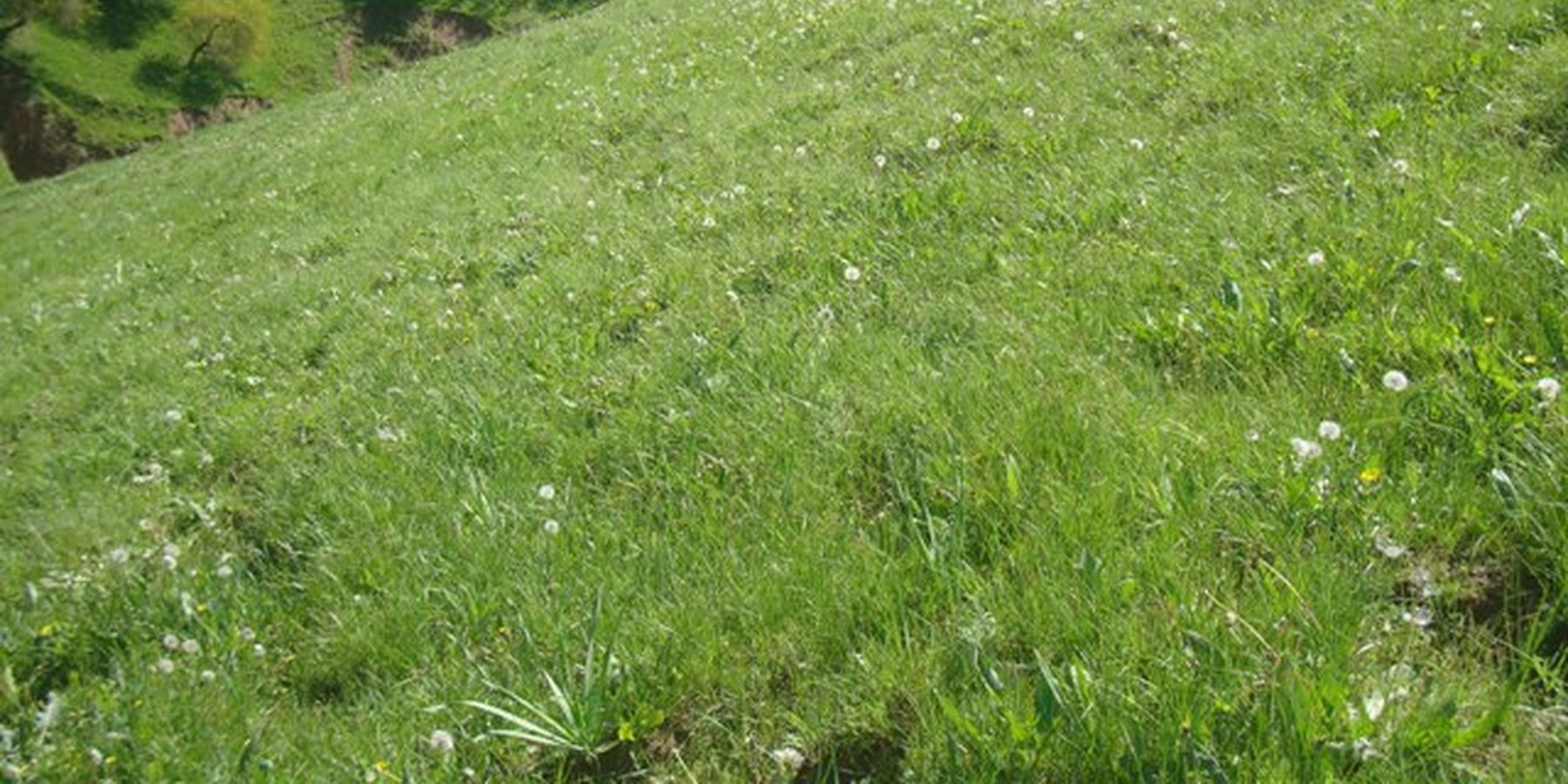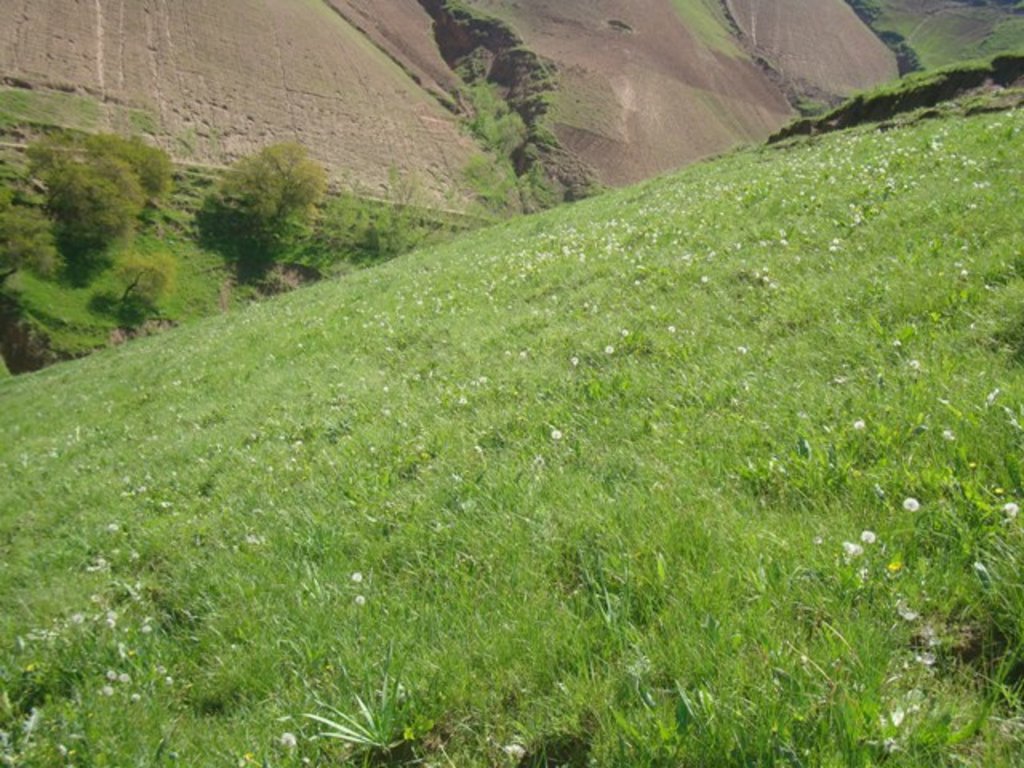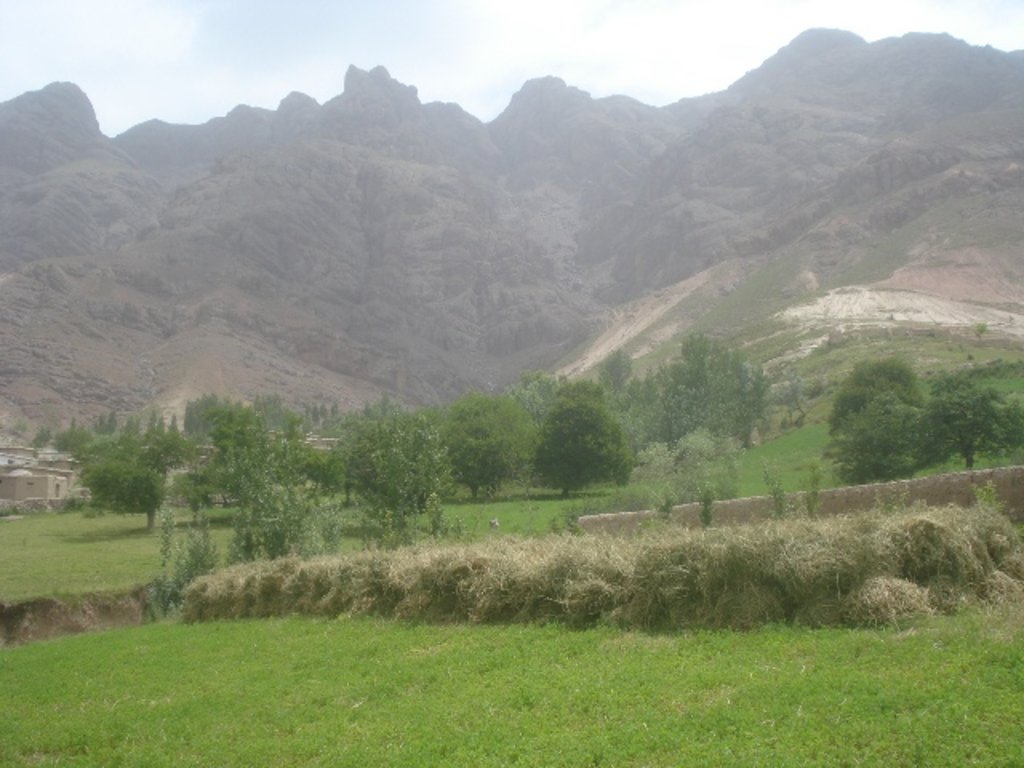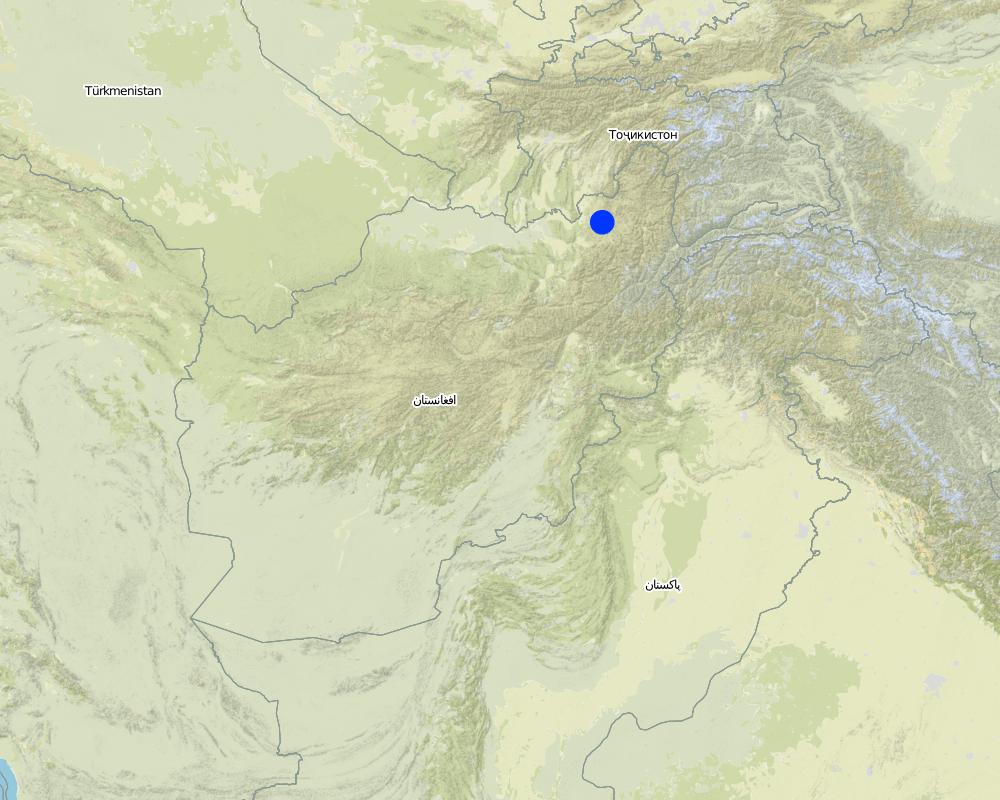Rehabilitation of degraded pastures with alfalfa [阿富汗]
- 创建:
- 更新:
- 编制者: Bettina Wolfgramm
- 编辑者: Roziya Kirgizbekova
- 审查者: Rima Mekdaschi Studer, Alexandra Gavilano
Ehyoye charogoh bo posheedani tukhmi reshqa
technologies_672 - 阿富汗
查看章节
全部展开 全部收起1. 一般信息
1.2 参与该技术评估和文件编制的资源人员和机构的联系方式
SLM专业人员:
Researcher:
有助于对技术进行记录/评估的项目名称(如相关)
Livelihood Improvement Project Takhar, Afghanistan (LIPT)有助于对技术进行记录/评估的项目名称(如相关)
Potential and limitations for improved natural resource management (NRM) in mountain communities in the Rustaq district, Afghanistan (Rustaq NRM Study)有助于对技术进行记录/评估的机构名称(如相关)
Terre des Hommes (Terre des Hommes) - 瑞士有助于对技术进行记录/评估的机构名称(如相关)
Swiss Agency for Development and Cooperation (DEZA / COSUDE / DDC / SDC) - 瑞士有助于对技术进行记录/评估的机构名称(如相关)
Bern University of Applied Sciences, School of Agricultural, Forest and Food Sciences (HAFL) - 瑞士有助于对技术进行记录/评估的机构名称(如相关)
CDE Centre for Development and Environment (CDE Centre for Development and Environment) - 瑞士1.3 关于使用通过WOCAT记录的数据的条件
编制者和关键资源人员接受有关使用通过WOCAT记录数据的条件。:
是
1.4 所述技术的可持续性声明
这里所描述的技术在土地退化方面是否存在问题,导致无法被认为是一种可持续的土地管理技术?:
否
注释:
SLM practices documented in the frame of the Rustaq NRM study were established only recently (1-3 years ago). It is too early for a final judgment on the sustainability of these technologies within the human and natural environment of Chokar watershed.
1.5 参考关于SLM方法(使用WOCAT记录的SLM方法)的调查问卷
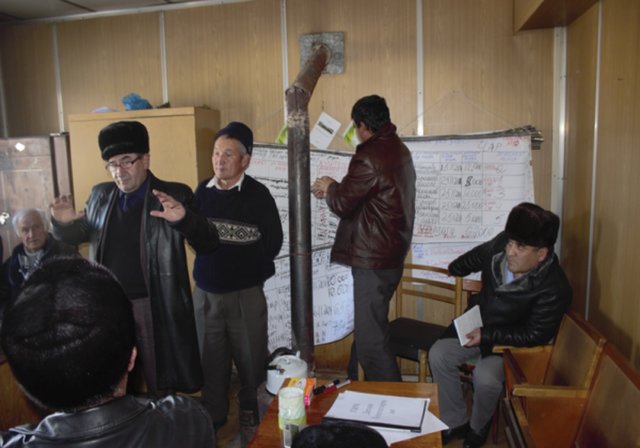
Pasture and Livestock Management Plan [塔吉克斯坦]
"Pasture and Livestock Management Plan" is a participatory approach which is guiding pasture users, members of Pasture User Unions and Pasture User Groups to develop their action plan on pasture and livestock management. The approach brings together stakeholders, who are involved at any stage in pasture management or can contribute …
- 编制者: Askarsho Zevarshoev
2. SLM技术的说明
2.1 技术简介
技术定义:
Degraded pastures are restored with alfalfa through broad seeding method. The area is put under quarantine for three years to allow for the pasture to restore sufficiently.
2.2 技术的详细说明
说明:
Project supported pasture rehabilitation has taken place in the villages Sari Joy, Jawaz Khana and Dashti Mirzai, located in Chokar watershed of Rustaq District in Northern Afghanistan. The Chokar watershed is a mountainous area situated between 600 - 2,500 m above sea level. The climate is semi-arid with harsh and cold weather in winter and hot and dry summers. The annual precipitation in average years is 580mm. Land degradation affects all forms of land use and includes low vegetation cover, heavy top soil erosion from water, and poor soil fertility. Unsustainable agricultural practices, over-exploitation and high pressure on the natural resources are adversely impacting on the socio-economic well-being of local communities as well as contributing to the risk for being adversely affected by drought as well as landslides and flash foods triggered by heavy rainfall. The data used for the documentation of the technology is based on field research conducted in Chokar watershed, namely in the villages: Sari Joy, Jawaz Khana and Dashti Mirzai. These villages represent the upper, the middle and the lower zone of Chokar watershed, respectively. They differ considerably in access to services and infrastructure, but in general are poorly served. The communities depend on land resources for sustaining their livelihoods. In a good year with high yields, wheat-self-sufficiency lasts about 5 months. The three villages are home to ethnic Qarluq communities. Since 2012 the Livelihood Improvement Project Takhar (LIPT) implemented by Terre des hommes (Tdh) Switzerland has initiated a range of NRM interventions.
Livestock keeping is one of the key livelihood strategies in rural Rustaq in addition to cultivation of cereals. Families rely on their livestock not only for consumption of meat from cows, goat and sheep, dairy products such as milk and sour milk, but also as means of transportation (donkeys), labour force in agriculture (oxen, donkey) and source of cash income. Every family strives to increase their household’s livestock as much as they can, which increases the pressure on the local pastures leading to extensive overgrazing. The pastures in Jawaz Khana, Dashti Mirzai and Sari Joy are characterized by poor vegetation cover, low carrying capacity and sever erosion with deep rills clearly visible on the surface. These severely degraded pastures continue to be used uncontrollably without any management schemes or regulations in place. Cropland not suitable for cultivation has been converted to pastures. The quantity and quality of livestock fodder is insufficient for all the livestock affecting poor animal health.
The village communities have recognized the poor condition of their pastures and the need to take measures to revert the situation. Pasture rehabilitation measures were introduced, which aim to restore heavily degraded pasture land with alfalfa. Initially the land user and the community agrees to leave the sown pasture under quarantine for three years. The restoration measures include: leveling the soil with a rack to soften the soil and prepare the seedbed. 3,5 kg of alfalfa is seeded on 1 jerib or 0.2 ha of pasture land using the broadcast seeding method. Fertilizer application (DAP and/or animal manure) is followed by the seeding. The area is protected from grazing during three years. During this quarantine period the alfalfa has to grow in sufficient size in order to be harvested for livestock fodder.
It has been observed that after two years in some part it is already possible to harvest the alfalfa. Improvements of the pasture are visible given the fast growth rate of the alfalfa crop. The plant grows well without irrigation, which is favorable given the shortage of irrigation water in the villages. The rehabilitated pastures will slow down the run-off, improve water infiltration and protect the pasture from erosion during heavy rain fall. The land users recognize the pasture improvements and relatively increased fodder availability. Alfalfa reseeding is done in 5-10 years and appeals to the needs of the land users, which cannot afford annual reseeding. One of the constraint remains is the quarantine period of 1-3 years, which deprives the livestock from fodder and the farmers have to find options for covering the loss.
Women are generally aware about the use of alfalfa for the production of better fodder for their livestock. Women do take part in haymaking, collecting the hay and bringing it to their homes or to the community fodder bank. Often they are helped by their children to do the work.
2.3 技术照片
2.5 已应用该技术的、本评估所涵盖的国家/地区/地点
国家:
阿富汗
区域/州/省:
Takhar Province, Rustaq District
有关地点的进一步说明:
Sari Joy, Jawaz Khana, Dashti Mirzai villages
具体说明该技术的分布:
- 均匀地分布在一个区域
如果不知道精确的区域,请注明大致覆盖的区域:
- < 0.1 平方千米(10 公顷)
注释:
This documentation is based on the experiences of SLM implementers from Sari Joy (7 treated plots), Jawaz Khana, (5 treated plots), and Dashti Mirzai (3 treated plots). Additionally insights were gained through interviews with both SLM implementers and observers from all three villages.
Map
×2.6 实施日期
如果不知道确切的年份,请说明大概的日期:
- 不到10年前(最近)
2.7 技术介绍
详细说明该技术是如何引入的:
- 通过项目/外部干预
注释(项目类型等):
Livelihood Improvement Project Takhar (LIPT) supported by Swiss Development Cooperation (SDC) from 2012-17
3. SLM技术的分类
3.1 该技术的主要目的
- 改良生产
- 减少、预防、恢复土地退化
3.2 应用该技术的当前土地利用类型

牧场
粗放式放牧:
- 半游牧畜牧业
集约放牧/饲料生产:
- 收割和携带/零放牧
动物类型:
- 山羊
- 绵羊
- cows
注释:
Number of growing seasons per year: 1
3.3 由于技术的实施,土地使用是否发生了变化?
由于技术的实施,土地使用是否发生了变化?:
- 是(请在技术实施前填写以下有关土地利用的问题)

农田
注释:
Some plots of the pastures are previous croplands, which have been strongly degraded and no longer used for crop cultivation.
3.4 供水
该技术所应用土地的供水:
- 混合雨水灌溉
3.5 该技术所属的SLM组
- 区域封闭(停止使用,支持恢复)
- 改良的地面/植被覆盖
3.6 包含该技术的可持续土地管理措施

植物措施
- V2:草和多年生草本植物

管理措施
- M1:改变土地使用类型
- M2:改变管理/强度级别
3.7 该技术强调的主要土地退化类型

土壤水蚀
- Wt:表土流失/地表侵蚀

土壤风蚀
- Et:表土流失

物理性土壤退化
- Pc:压实

生物性退化
- Bc:植被覆盖的减少
- Bq:数量/生物量减少

水质恶化
- Ha:干旱化
3.8 防止、减少或恢复土地退化
具体数量名该技术与土地退化有关的目标:
- 减少土地退化
- 修复/恢复严重退化的土地
4. 技术规范、实施活动、投入和成本
4.1 该技术的技术图纸
技术规范(与技术图纸相关):
The degraded land is selected for rehabilitation. The preparation of seedbed consists of leveling the soil with a rack to make it even and soften the topsoil. Alfalfa seed is sown through broadcast seeding method. The amount of seeds for 0.2 ha of land is 3.5 kg of alfalfa seeds. Fertilizer is applied during the seeding. The pastures are rainfed in general, but those area which have higher water availability, irrigate their plots during dry season. The seeded pasture is closed for quarantine for three years and the livestock is not allowed in the area. There is no fence around the pasture.
作者:
Roziya Kirgizbekova
日期:
05/06/2017
4.2 有关投入和成本计算的一般信息
具体说明成本和投入是如何计算的:
- 每个技术区域
注明尺寸和面积单位:
1 ha
具体说明成本计算所用货币:
- 美元
如相关,注明美元与当地货币的汇率(例如1美元=79.9巴西雷亚尔):1美元=:
67.0
注明雇用劳工的每日平均工资成本:
5.2-5.3 USD
4.3 技术建立活动
| 活动 | 时间(季度) | |
|---|---|---|
| 1. | Selection of the land for rehabilitation | Fall |
| 2. | Leveling the land with a rake | Fall |
| 3. | Sowing alfalfa (broadcast seeding) | Spring |
| 4. | Site under quarantine | Three years |
| 5. | Site protection | Three years |
4.4 技术建立所需要的费用和投入
| 对投入进行具体说明 | 单位 | 数量 | 单位成本 | 每项投入的总成本 | 土地使用者承担的成本% | |
|---|---|---|---|---|---|---|
| 劳动力 | Leveling the land | person-day | 100.0 | 5.3 | 530.0 | 100.0 |
| 劳动力 | Sowing alfalfa | person-day | 5.0 | 5.3 | 26.5 | 100.0 |
| 劳动力 | Site protection | year | 1.0 | 447.0 | 447.0 | 100.0 |
| 设备 | Shovel | piece | 1.0 | 3.8 | 3.8 | 100.0 |
| 设备 | Rope | meter | 50.0 | 0.07 | 3.5 | 100.0 |
| 设备 | Rake | piece | 1.0 | 3.0 | 3.0 | |
| 植物材料 | Alfalfa seed | 17.5 | 0.42 | 7.35 | ||
| 肥料和杀菌剂 | DAP | kg | 125.0 | 0.9 | 112.5 | |
| 肥料和杀菌剂 | Urea | Kg | 125.0 | 0.45 | 56.25 | 100.0 |
| 技术建立所需总成本 | 1189.9 | |||||
| 技术建立总成本,美元 | 17.76 | |||||
如果土地使用者负担的费用少于100%,请注明由谁负担其余费用:
Livelihood Improvement Project Takhar (LIPT) implemented by Terre des hommes (Tdh) Switzerland
注释:
Costs calculated for a Technology area of 1ha was only done for the purpose of the WOCAT documentation. In reality SLM plots are on average 0.2-0.4 ha or 1-2 jeribs. Costs were simply multiplied by 5. The actual costs for a 1ha plot might be slightly different.
4.5 维护/经常性活动
| 活动 | 时间/频率 | |
|---|---|---|
| 1. | Hay making | Summer |
| 2. | Delivery of hay to the fodder bank | Fall |
| 3. | Protection of the pasture during quarantine | Three years |
4.6 维护/经常性活动所需要的费用和投入(每年)
| 对投入进行具体说明 | 单位 | 数量 | 单位成本 | 每项投入的总成本 | 土地使用者承担的成本% | |
|---|---|---|---|---|---|---|
| 劳动力 | Hay making | person day | 35.0 | 5.3 | 185.5 | 100.0 |
| 劳动力 | Delivery of the hay to the fodder bank | person day | 35.0 | 5.3 | 185.5 | 100.0 |
| 劳动力 | Protection during quarantine | year | 2.0 | 447.0 | 894.0 | 100.0 |
| 设备 | Sickle | piece | 1.0 | 2.25 | 2.25 | 100.0 |
| 设备 | Pitchfork | piece | 1.0 | 5.3 | 5.3 | 100.0 |
| 技术维护所需总成本 | 1272.55 | |||||
| 技术维护总成本,美元 | 18.99 | |||||
注释:
Costs calculated for a Technology area of 1ha was only done for the purpose of the WOCAT documentation. In reality SLM plots are on average 0.2-0.4 ha or 1-2 jeribs. Costs were simply multiplied by 5. The actual costs for a 1ha plot might be slightly different.
4.7 影响成本的最重要因素
描述影响成本的最决定性因素:
Due to the remoteness of the villages where the technology has been implemented, all the inputs for establishment, such as agricultural equipment, plant material, fertilizers, etc., are purchased in Rustaq town. The expenses for traveling and delivering the inputs affect the establishment costs.
5. 自然和人文环境
5.1 气候
年降雨量
- < 250毫米
- 251-500毫米
- 501-750毫米
- 751-1,000毫米
- 1,001-1,500毫米
- 1,501-2,000毫米
- 2,001-3,000毫米
- 3,001-4,000毫米
- > 4,000毫米
指定年平均降雨量(若已知),单位为mm:
580.00
有关降雨的规范/注释:
Average annual percipitation for the area was calculated with 580 mm, with minimums in dry years (2000 and 2001) of 270 mm and maximums in wet years (2009/2010) of 830 mm. The absolut maximum rainfall was calculated for 1986 with 1024 mm. The data series covers the time from 1979 to 2014.
注明所考虑的参考气象站名称:
Climate Forecast System Reanalysis (CFSR), http://rda.ucar.edu/pub/cfsr.html
农业气候带
- 半干旱
Derived from the publicly available dataset on length of growing period (LGP) (Fischer 2009 / IIASA-FAO). Internet link: http://tiles.arcgis.com/tiles/P8Cok4qAP1sTVE59/arcgis/rest/services/Length_of_growing_period/MapServer
5.2 地形
平均坡度:
- 水平(0-2%)
- 缓降(3-5%)
- 平缓(6-10%)
- 滚坡(11-15%)
- 崎岖(16-30%)
- 陡峭(31-60%)
- 非常陡峭(>60%)
地形:
- 高原/平原
- 山脊
- 山坡
- 山地斜坡
- 麓坡
- 谷底
垂直分布带:
- 0-100 m a.s.l.
- 101-500 m a.s.l.
- 501-1,000 m a.s.l.
- 1,001-1,500 m a.s.l.
- 1,501-2,000 m a.s.l.
- 2,001-2,500 m a.s.l.
- 2,501-3,000 m a.s.l.
- 3,001-4,000 m a.s.l.
- > 4,000 m a.s.l.
5.3 土壤
平均土层深度:
- 非常浅(0-20厘米)
- 浅(21-50厘米)
- 中等深度(51-80厘米)
- 深(81-120厘米)
- 非常深(> 120厘米)
土壤质地(表土):
- 中粒(壤土、粉土)
土壤质地(地表以下> 20厘米):
- 中粒(壤土、粉土)
表土有机质:
- 中(1-3%)
- 低(<1%)
如有可能,附上完整的土壤描述或具体说明可用的信息,例如土壤类型、土壤酸碱度、阳离子交换能力、氮、盐度等。:
Local land users differentiate between the following soil types where the technology is implemented:
- Light soils: moderately deep; texture of topsoil medium (loamy, silty); low topsoil organic matter
- Dark soils: moderately deep; texture of topsoil medium (loamy, silty); medium topsoil organic matter
5.4 水资源可用性和质量
地下水位表:
5-50米
地表水的可用性:
中等
水质(未处理):
良好饮用水
水的盐度有问题吗?:
否
该区域正在发生洪水吗?:
是
规律性:
偶然
关于水质和水量的注释和进一步规范:
Floods occur mainly during the rainy seasons in spring and autumn. Availability of surface water differs for the three study villages Sari Joy, Jawaz Khana, and Dashti Mirzai. Sari Joy has sources and good surface water availability. Jawaz Khana has poor water availability as water has to be fetched from a lower laying stream. Dashti Mirzai has good water availability also from an irrigation channel.
5.5 生物多样性
物种多样性:
- 低
栖息地多样性:
- 低
5.6 应用该技术的土地使用者的特征
定栖或游牧:
- 定栖的
生产系统的市场定位:
- 生计(自给)
非农收入:
- 收入的10-50%
- > 收入的50%
相对财富水平:
- 贫瘠
个人或集体:
- 个人/家庭
机械化水平:
- 手工作业
性别:
- 女人
- 男人
土地使用者的年龄:
- 中年人
- 老年人
说明土地使用者的其他有关特征:
The land users in the area where the Technology is applied belong to the Uzbek ethnic minority group Qarluq.
Although the men are generally the main land users, however, women and children also take active part in the related work. The functions of men and women are clearly distinguished within the Afghan society. At the same time within the family this division of work and functions also results in men and women working hand-in-hand. An improvement of the family’s livelihood situation is expected to positively affect all family members. While, it is recognized that the involvement of women is key in order to secure basic human rights for everyone, to achieve good governance, sustainable development, and to efficiently contribute to poverty reduction (SDC 2004), it is also clear that a context sensitive approach is of high importance.
Women in rural Afghanistan are involved in many production and income generating activities that contribute to the overall household income, however, very few women own resources such as land and livestock, and their income generating options are fewer in comparison to that of men.
5.7 应用该技术的土地使用者使用的平均土地面积
- < 0.5 公顷
- 0.5-1 公顷
- 1-2 公顷
- 2-5公顷
- 5-15公顷
- 15-50公顷
- 50-100公顷
- 100-500公顷
- 500-1,000公顷
- 1,000-10,000公顷
- > 10,000公顷
这被认为是小规模、中规模还是大规模的(参照当地实际情况)?:
- 中等规模的
5.8 土地所有权、土地使用权和水使用权
土地所有权:
- 个人,未命名
土地使用权:
- 个人
用水权:
- 社区(有组织)
注释:
Those who own land and use water for irrigation are obliged to pay for the water. The payment is made both in kind and in cash to the Mirob - the person in charge of distributing water in the community. The amount of the payment varies from village to village.
6. 影响和结论性说明
6.1 该技术的现场影响
社会经济效应
生产
饲料生产
注释/具体说明:
Alfalfa is a fast growing forage crop with high yields. Cultivation of alfalfa and in some areas alfalfa and sainfoin has the advantage of providing quality fodder in sufficient amounts.
畜牧生产
注释/具体说明:
Sufficient amount of quality fodder and its availability in longer periods, particularly during winter and spring has a positive impact on animal health and productivity.
产品多样性
注释/具体说明:
Negligible impact on diversity of fodder products. Main crops are alfalfa and sainfoin.
社会文化影响
食品安全/自给自足
注释/具体说明:
The sum of improved access and availability of fodder and better animal health, is expected to have positive impact on household's food security and self-sufficiency.
SLM/土地退化知识
注释/具体说明:
Land users learned how to apply SLM measures to restore heavily degraded land and grow better fodder for livestock.
社会经济弱势群体的情况
注释/具体说明:
Female headed households are not included. Technology is mostly implemented on private land. People without land are using common pastures. They have the opportunity to earn income as a hired worker for the SLM implementers.
生态影响
水循环/径流
地表径流
土壤
土壤流失
注释/具体说明:
Alfalfa develops a strong root system, which stabilizes the soil and prevents soil loss.
生物多样性:植被、动物
植被覆盖
注释/具体说明:
Alfalfa is a perennial crop, which grows up to 5 years without reseeding and thereby helps to increase the vegetation cover over longer periods.
6.2 该技术的场外影响已经显现
下游洪水
下游淤积
缓冲/过滤能力
对场外影响(测量)的评估进行具体说明:
These comments apply to 6.1 and 6.2:
- Socio-economic impacts: Individual SLM implementers were asked to rate the benefits from the technology. They were asked to indicate production increase of crops; fodder; animals; wood; non-wood forest products; increase in product diversity; or production area. The most important increase they rated with 3, the second most with 2, others with 1 point. Averages of the points given by all SLM implementers are reflected here.
- Similarly for the "ecological impacts" and on "off-site impacts": Individual SLM implementers were asked to rate the on-site and off-site impacts of the technology on water; soil; and vegetation. They were asked to indicate the strength of impacts with three, two or one points. Averages of the points given by all SLM implementers are reflected here.
- Socio-cultural impacts: This section is answered by the scientists, based on information collected during focus group discussions, and interviews conducted with persons from the 3 villages where the LIPT project implemented the technology.
6.3 技术对渐变气候以及与气候相关的极端情况/灾害的暴露和敏感性(土地使用者认为的极端情况/灾害)
气候有关的极端情况(灾害)
气象灾害
| 该技术是如何应对的? | |
|---|---|
| 局地暴雨 | 非常好 |
气候灾害
| 该技术是如何应对的? | |
|---|---|
| 干旱 | 好 |
注释:
SLM implementers from three villages were asked to jointly discuss and rate how much the SLM technology reduced the lands vulnerability to drought and local rainstorms. Only vulnerability to the most prevalent climate extremes (drought and local rainstorms) was discussed. SLM technologies were rated as reducing vulnerability poorly , well, or very well. The average points reflected here are from multi-criteria matrixes compiled in three villages where the SLM technology had been implemented.
6.4 成本效益分析
技术收益与技术建立成本相比如何(从土地使用者的角度看)?
短期回报:
非常积极
长期回报:
非常积极
注释:
SLM implementers from three villages were asked to jointly discuss and rate the SLM technologies short term (1-3 years) and long-term (10 years) return. As most of the technologies have only been implemented 1-2 years ago, it is too early to compare benefits to maintenance costs. Farmers have little experience so far on the actual benefits of the SLM technologies. The ratings are mostly based on expected benefits and not on actual benefits. During the ranking the land users also did not account for the project support they received for the establishment of the technology.
6.5 技术采用
- 1-10%
如若可行,进行量化(住户数量和/或覆盖面积):
6.1 ha
在所有采用这项技术的人当中,有多少人是自发的,即未获得任何物质奖励/付款?:
- 11-50%
注释:
Individual SLM implementers were asked whether they received support for implementing the Technology. Each indicated the type of support he received from the proposed options: "Full Support 100%, Some Support, No Support 0%". 20% implemented the Technology without receiving support.
6.6 适应
最近是否对该技术进行了修改以适应不断变化的条件?:
否
6.7 该技术的优点/长处/机会
| 土地使用者眼中的长处/优势/机会 |
|---|
| The technology does not require too much labor and material inputs for establishment work. |
| Alfalfa grows well and it can be harvested several years in a row without reseeding. The land users expect to have sufficient supplies of fodder during winter, which is the most difficult season to prevent animal loss and shortage of fodder is one of the main reasons. Alfalfa is considered as a good fodder for the, which makes it strong. |
| Sowing alfalfa is a good method to make better use of bad lands or degraded cropland. Some land users plan to sow alfalfa on their lands, which are not fit for crop cultivation. |
| 编制者或其他关键资源人员认为的长处/优势/机会 |
|---|
| The decision to grow alfalfa on the degraded cropland and pasture land is an efficient and low-cost technology. It makes it possible to produce good fodder on the degraded land under low or no availability of irrigation water. At the same time the plant has a good feature in terms of enhancing moisture retention and halting soil erosion. |
| Land users learn about sustainable land management practices adapted to their local conditions and needs. The land users can collect their own seeds to use for seeding in the future. |
| Female members of the family help to protect the plot. |
6.8 技术的弱点/缺点/风险及其克服方法
| 土地使用者认为的弱点/缺点/风险 | 如何克服它们? |
|---|---|
| Land users expressed concerns that in 5 years they have to reseed again the alfalfa and they don't have seeds for it. | |
| Some land users' expectations were not met as they planned to sow alfalfa on bigger land, but in reality could only sow on 1-2 jeribs (0.2-0.4 ha). | |
| Female family members take part in haymaking and delivery of the hay to their homes or to the fodder storage. This increases their daily workload. |
| 编制者或其他关键资源人员认为的弱点/缺点/风险 | 如何克服它们? |
|---|---|
| There is no fence to protect the pasture from grazing during the quarantine period. Grazing on the pasture during quarantine may affect the quality of the pasture. The land user has to hire a guard to protect the pasture or the family members have to protect the plot. |
Further awareness raising about the importance of the quarantine regime within the village community. Affordable options for area closure, at least during quarantine. |
| The quarantine period of 1-3 years deprives the land user of its pasture and limits fodder production significantly. Although the land users did not specifically raise their concern about the quarantine, however it presents a major disadvantage in an area where there is already a shortage of grazing land and fodder. Such situation might cause conflict over the use of pasture land in the village. | |
| Not all land users are aware of seed collection or practice seed collection, which could be very helpful to save costs for buying alfalfa seeds. They could also sell their surplus seeds. | |
| The use of fertilizer is perceived by the land user as an important factor for growing quality fodder. Such perception might increase the reliance of land users on applying chemical fertilizers, rather than engaging in sustainable management of the plot. |
7. 参考和链接
7.1 信息的方法/来源
- 实地考察、实地调查
No field visits were held.
- 与土地使用者的访谈
Focus group discussions (FGD) were organized by CDE team to collect information from SLM implementers. Total of 15 land users who have rehabilitated their pastures with alfalfa participated in the FGDs held in the three villages of Sari Joy, Jawaz Khana and Dashti Mirzai.
Interviews were conducted by the HAFL team to collect information from persons representing all the three study villages.
- 与SLM专业人员/专家的访谈
Close collaboration took place during the compilation of this material with the technical staff of the LIPT project in Rustaq.
- 根据报告和其他现有文档进行编译
Information provided in the reports of the LIPT project in Rustaq served as an initial source of information during the preparatory phase and also solidifying the description of the technology and area of implementation. Other background papers on Afghanistan were referred to for general information on agriculture and natural resource management in Afghanistan.
(现场)数据是什么时候汇编的?:
17/10/2016
7.2 参考可用出版物
标题、作者、年份、ISBN:
Guidelines for Focus Groups Discussions
标题、作者、年份、ISBN:
Methods section of the Rustaq NRM study
链接和模块
全部展开 全部收起链接

Pasture and Livestock Management Plan [塔吉克斯坦]
"Pasture and Livestock Management Plan" is a participatory approach which is guiding pasture users, members of Pasture User Unions and Pasture User Groups to develop their action plan on pasture and livestock management. The approach brings together stakeholders, who are involved at any stage in pasture management or can contribute …
- 编制者: Askarsho Zevarshoev
模块
无模块


